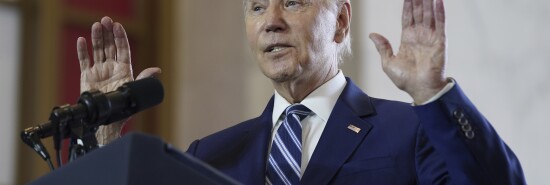
Nobody knows what the future of electric cars will be — not even Biden
Timothy P. Carney
Video Embed
When I arrived at college in 1996, the school was in the middle of an ambitious infrastructure project: wiring the campus, from classrooms and library study carrels to dorm rooms and common areas, with ethernet. By the time this project was done, wireless internet had made the whole thing obsolete.
The Biden administration should keep this in mind as it tries to build a national network of outlets for plug-in cars.
CALIFORNIA REPARATIONS: WHAT NEWSOM SAID AHEAD OF TASK FORCE’S FINAL PROPOSAL
Why the heck should the government subsidize charging ports for electric cars?
Plug-in electric cars are getting better, and it’s very likely that they will continue to grow as a share of all cars owned and driven in the United States. Drivers who love plug-in electric cars will benefit from this expansion, as will consumers who simply want more choices.
There’s reason to believe the general public will also benefit if some normal cars, with internal-combustion engines, are replaced by plug-in electrics. Downtowns will have a lot less pollution and less noise. Users of gasoline cars will benefit in the short term as demand for gasoline goes down, thus alleviating the chokepoint at refineries and lowering prices for a while. And burning less petroleum means fewer greenhouse gas emissions.
These possible benefits to non-car-owners are what economists call “positive externalities,” and positive externalities are often used to justify government interference. If many of the benefits of a thing are not captured by the owner of the thing, commentators argue, it makes sense for the public to subsidize the thing.
That’s one justification for subsidizing plug-in cars — and, boy, have we subsidized them.
As much as we’ve subsidized Tesla, Ford, and other electric car-makers, policymakers and politicians are even more intent on subsidizing a network of chargers for these cars. Here, they have another justification on top of the above ones: a supposed market failure in which people won’t buy electric cars unless there are enough chargers, and the market won’t build enough chargers unless enough people own and drive electric cars.
Thus, the Biden administration is using $7.5 billion in tax dollars to pay companies to install hundreds of thousands of chargers around the country.
This all sounds reasonable to the average nonlibertarian. But the standard arguments against government intervention in industry still apply.
The main arguments are two: (1) All this money flying from bureaucrats to private companies is an occasion for cronyism and self-dealing, and (2) centralizing the decision-making on the shape of the infrastructure risks massive investment in technology that quickly becomes obsolete — such as the ethernet network on campus.
We need to start by acknowledging that we don’t know what the future holds for electric cars. Will they ever get ranges that compete with gas-powered cars? Will batteries improve, and if so, in which ways? Will the current lithium-ion battery technologies continue to reign, or will one of a dozen other types of battery become dominant?
Here’s one technology that doesn’t quite work yet but has lots of upside potential: swappable batteries. What if you dealt with a low car battery the way you dealt with an empty propane tank? Drop off the empty one, plug in a full one, and leave the empty one for someone else to charge.
Ample is a startup company that is developing “swapping stations” that can swap out a drained battery for a full one in five minutes. Theoretically, almost any EV could use these stations.
There are dozen of reasons this might not work. But it might! And wouldn’t it be stupid for the federal government to install 500,000 charging stations when 10 years from now, zero people might charge their cars anywhere but at home?
Also, Biden’s $7.5 billion for chargers comes with rules that run the risk of prescribing suboptimal business models. The model laid out by the regulations involves charging stations that are 50 miles apart along highways and that have at least four chargers per station — basically, the same model as a gas station.
But people don’t charge their cars the same way they fill up their gas, in part because pumping gas is a brief stop that takes about the same amount of time as using the bathroom and buying some beef jerky. Recharging a car on a road trip takes much longer.
Some people recharge their cars while stopping for a sit-down lunch. People might add just a bit of charge to their car while doing grocery shopping. People want to recharge their car while sleeping at a Holiday Inn.
CLICK HERE TO READ MORE FROM THE WASHINGTON EXAMINER
There’s no reason to believe that recharging stations, with four chargers each, 50 miles apart, best serve the needs of EV drivers. But that’s where the federal money is going, so that’s where the recharger investment will go.
I agree with those who say that EVs are a car of the future. I just worry that Biden might not be the best man to predict the future of electric transportation.
